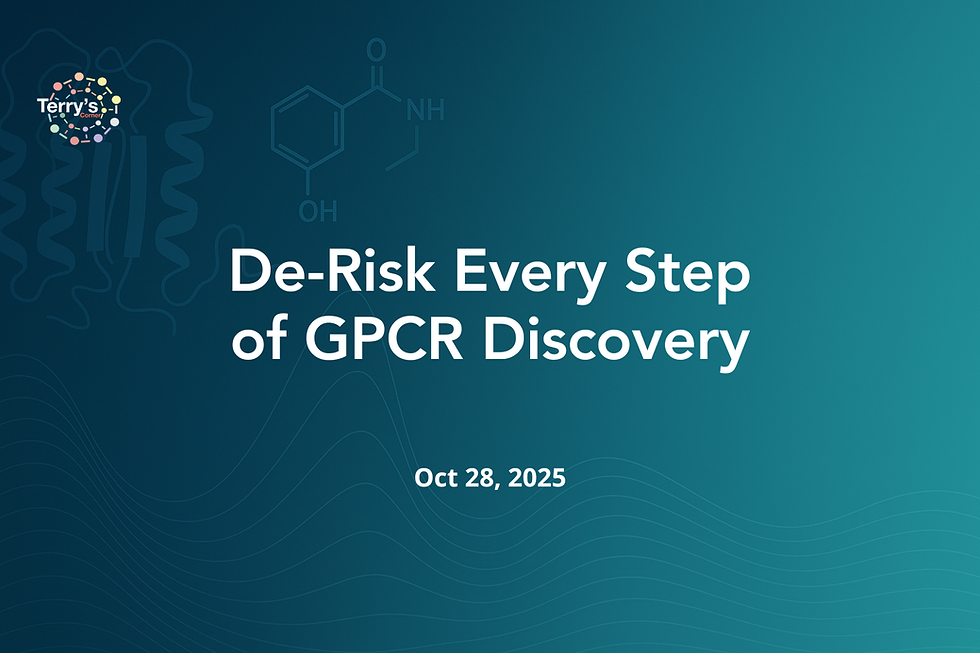Chemical Drug Matter : Rethinking the Molecules We Choose to Develop In Drug Discovery
- Terry's Desk

- Nov 11
- 4 min read

Pipeline Efficiency Begins With the Chemistry Itself
Drug discovery pipelines often stall not because the target is wrong—but because the chemical matter interacting with that target lacks the right properties to produce meaningful pharmacology. We obsess over target validation, signaling pathways, expression patterns, and disease relevance. Yet, far less time is spent scrutinizing the structural logic and origin of the molecules we screen in the first place.
This lesson asks a deceptively simple question: What if our molecules—not our targets—are limiting discovery?
In this lesson, you’ll gain:
A strategic view of how chemical scaffolds shape pharmacologic outcomes
An understanding of new chemical sources beyond natural agonist analogs
Awareness of how GPCR allostery and biased signaling are redefining drug design
The Long Arc of Chemical Pharmacology
The early history of drug discovery was rooted in nature. Extracts from plants, fungi, bacteria, and environmental microorganisms provided the first potent modulators of physiology.
Opium, for example, was used for dysentery and relief of suffering as early as the 3rd century BC; its derivatives — morphine, codeine, papaverine — became cornerstones of modern therapy.
The natural world still holds enormous untapped potential. Less than ~15% of higher plant species, <5% of bacterial and fungal species, and only a fraction of marine organisms have been meaningfully explored.
Yet natural-product scaffolds come with costs: they are structurally complex, expensive to modify, often unpredictable in IP, and sometimes more difficult to optimize for modern pharmacokinetics.
Still, nature remains a treasure map — just one that requires more strategic navigation.
The key question Terry raises:
If natural scaffolds provided our starting pharmacology, what new scaffolds will define the next 50 years?
Building on Known Pharmacology
Medicinal chemists learned early that modifying endogenous molecules — hormones, neurotransmitters, and metabolic signals — could yield new drug effects.
Adenine-derived scaffolds enabled selective adenosine receptor antagonists; tryptophan modifications led to somatostatin receptor ligands.
From these efforts emerged the concept of privileged structures: chemical backbones that show repeat utility across GPCR classes and receptor families. Indoles, benzodiazepines, phenethylamines — each recurs because it “fits” biology well.
This was more than trial-and-error. It was early structure-based pharmacology.
Dr. Kenakin highlights how hybrid molecules — combining two pharmacophores into one scaffold — enable dual-modality treatments with unified pharmacokinetics (instead of juggling two separate drugs with mismatched ADME profiles).
And occasionally, new chemistry emerges from an unexpected source: Side effects.
Diuretic action discovered in sulfanilamide derivatives led to furosemide; sedative effects of early antihistamines helped launch antipsychotics.
Lesson: The structure-response relationship is rarely linear — and observing the unexpected is part of the craft.
Informatics Expands the Search Space for Chemical Drug Matter
Advances in chemoinformatics introduced large-scale similarity mapping, such as SEA (Similarity Ensemble Approach), which compares the chemical similarity of ligands, not the protein sequence of targets.
This is a philosophical shift: Instead of asking, “Which proteins are related?”
We ask, “Which molecules behave as if they belong together?”
This approach reveals:
Hidden target overlap
New therapeutic hypotheses
“Off-target” effects that may be on-target opportunities
This expands drug matter beyond the familiar and encourages deliberate exploration of chemical novelty, rather than incremental tuning of existing scaffolds.
The molecule, not the receptor, becomes the guiding principle.
Allostery and Biased Signaling Change the Game
The most profound change in GPCR drug discovery is our expanding understanding of allosteric receptor function. GPCRs are not simple on/off switches. They are allosteric machines, able to shift conformational states in response to multiple binding influences.
This enables:
Positive Allosteric Modulators (PAMs) — enhance natural signaling
Negative Allosteric Modulators (NAMs) — attenuate signaling
Biased agonists — favor one intracellular pathway over another
These are not analogs of natural transmitters. They are structural strategies for tuning physiology.
This reroutes discovery toward:
Functionally selective ligands
Better therapeutic windows
More predictable clinical behavior
Allosteric modulation allows us to work with biology’s dynamic systems instead of forcing orthosteric competition.
Biologics Are Now Chemical Drug Matter, Too
Proteins, peptides, and antibodies are no longer niche. They are mainstream pharmacology.
They offer high specificity, favorable safety, and unique mechanisms, including GPCR modulation through agonism, internalization, or ligand scavenging.
Advances in formulation and delivery have overcome earlier pharmacokinetic limitations.
Peptide GPCR therapies now address obesity, diabetes, cancer, neuroendocrine disorders, inflammatory diseases, and more.
The boundary between “small molecule” and “biologic” has blurred.
What matters now is not the category, but the fit:
Does the chemical matter support the therapeutic mechanism?
Does it interact with the receptor in a way that biology can use?
Core message: The receptor is only half the story. The molecule is the other half.
Why Terry’s Corner
Terry’s Corner is a continuously growing knowledge platform built for scientists who want sharper decision-making power in discovery pharmacology.
Subscribers gain weekly lectures led by Dr. Terry Kenakin, monthly AMA discussions, and on-demand access to a library of expert GPCR teaching sessions. Members can also propose new topics, ensuring relevance to real-world discovery problems.
This is strategic, method-proven insight for discovery teams, pharmacologists refining core skills, and R&D leads who need clear reasoning in a rapidly changing field. GPCR innovation is accelerating. Those who learn now will shape the drugs others spend the next decade trying to understand.
40 years of expertise at your fingertips:





Comments